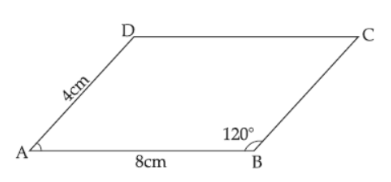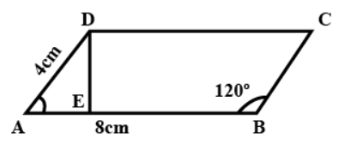
ABCD is a parallelogram with AB=8cm, AD=4cm, \[\angle B=120{}^\circ \]
(a) What is $\angle $A?
(b) What is the perpendicular distance from D to AB?
(c) What is the area of ABCD?


Answer
600.3k+ views
Hint: Use the property of parallelogram that opposite angles of a parallelogram are equal. Then use the property that the sum of all angles of a quadrilateral is \[360{}^\circ \] . For the second part, use cosine of angle A found from the first part to find perpendicular distance. For the third part, use the formula for Area of parallelogram = Length of base \[\times \] Height .
Complete step-by-step answer:
We are given that ABCD is a parallelogram with AB=8cm, AD=4cm, \[\angle B=120{}^\circ \]
We need to find the following
(a) $\angle $A
(b) the perpendicular distance from D to AB
(c) the area of ABCD
Let us first solve (a).
We know that the opposite angles of a parallelogram are equal.
Using this, \[\angle B=\angle D=120{}^\circ \]
And, \[\angle A=\angle C\]
Also, we know that the sum of all angles of a quadrilateral is \[360{}^\circ \] .
\[\angle A+\angle B+\angle C+\angle D=360{}^\circ \]
Substituting the relations between the angles in this equation, we will get the following:
\[2\angle A+2\angle B=360{}^\circ \]
\[2\angle A+2\times 120{}^\circ =360{}^\circ \]
\[2\angle A+240{}^\circ =360{}^\circ \]
\[2\angle A=120{}^\circ \]
So, \[\angle A=60{}^\circ \]
Now, let us solve (b)
For this, draw DE as perpendicular from D to AB as shown in the figure.
We need to find the length of DE.

Now, we found in the previous part that \[\angle A=60{}^\circ \]
We also know that \[\sin 60{}^\circ =\dfrac{\sqrt{3}}{2}\]
So, \[\sin \angle A=\dfrac{DE}{AD}=\dfrac{\sqrt{3}}{2}\]
\[\sin \angle A=\dfrac{DE}{4}=\dfrac{\sqrt{3}}{2}\]
This gives us: \[DE=2\sqrt{3}\] cm
So, the perpendicular distance from D to AB is \[2\sqrt{3}\] cm.
Now, we will solve (c).
We need to find the area of ABCD.
We know that:
Area of parallelogram = Length of base \[\times \] Height
Here, we have length of base, AB = 8 cm
Height, DE = \[2\sqrt{3}\] cm
Putting these values in the formula, we will get the following:
Area of ABCD = Length of AB \[\times \] Length of DE
Area of ABCD = \[8\times 2\sqrt{3}\] \[=16\sqrt{3}c{{m}^{2}}\]
So, Area of ABCD is \[16\sqrt{3}c{{m}^{2}}\]
Note: You have to remember the various geometrical properties to solve this kind of question. For example, in this question too, you need to use the properties like opposite angles of a parallelogram are equal and that the sum of all angles of a quadrilateral is \[360{}^\circ \]
Complete step-by-step answer:
We are given that ABCD is a parallelogram with AB=8cm, AD=4cm, \[\angle B=120{}^\circ \]
We need to find the following
(a) $\angle $A
(b) the perpendicular distance from D to AB
(c) the area of ABCD
Let us first solve (a).
We know that the opposite angles of a parallelogram are equal.
Using this, \[\angle B=\angle D=120{}^\circ \]
And, \[\angle A=\angle C\]
Also, we know that the sum of all angles of a quadrilateral is \[360{}^\circ \] .
\[\angle A+\angle B+\angle C+\angle D=360{}^\circ \]
Substituting the relations between the angles in this equation, we will get the following:
\[2\angle A+2\angle B=360{}^\circ \]
\[2\angle A+2\times 120{}^\circ =360{}^\circ \]
\[2\angle A+240{}^\circ =360{}^\circ \]
\[2\angle A=120{}^\circ \]
So, \[\angle A=60{}^\circ \]
Now, let us solve (b)
For this, draw DE as perpendicular from D to AB as shown in the figure.
We need to find the length of DE.

Now, we found in the previous part that \[\angle A=60{}^\circ \]
We also know that \[\sin 60{}^\circ =\dfrac{\sqrt{3}}{2}\]
So, \[\sin \angle A=\dfrac{DE}{AD}=\dfrac{\sqrt{3}}{2}\]
\[\sin \angle A=\dfrac{DE}{4}=\dfrac{\sqrt{3}}{2}\]
This gives us: \[DE=2\sqrt{3}\] cm
So, the perpendicular distance from D to AB is \[2\sqrt{3}\] cm.
Now, we will solve (c).
We need to find the area of ABCD.
We know that:
Area of parallelogram = Length of base \[\times \] Height
Here, we have length of base, AB = 8 cm
Height, DE = \[2\sqrt{3}\] cm
Putting these values in the formula, we will get the following:
Area of ABCD = Length of AB \[\times \] Length of DE
Area of ABCD = \[8\times 2\sqrt{3}\] \[=16\sqrt{3}c{{m}^{2}}\]
So, Area of ABCD is \[16\sqrt{3}c{{m}^{2}}\]
Note: You have to remember the various geometrical properties to solve this kind of question. For example, in this question too, you need to use the properties like opposite angles of a parallelogram are equal and that the sum of all angles of a quadrilateral is \[360{}^\circ \]
Recently Updated Pages
Master Class 12 Business Studies: Engaging Questions & Answers for Success

Master Class 12 Economics: Engaging Questions & Answers for Success

Master Class 12 English: Engaging Questions & Answers for Success

Master Class 12 Maths: Engaging Questions & Answers for Success

Master Class 12 Social Science: Engaging Questions & Answers for Success

Master Class 12 Chemistry: Engaging Questions & Answers for Success

Trending doubts
Which places in India experience sunrise first and class 9 social science CBSE

Fill the blanks with the suitable prepositions 1 The class 9 english CBSE

Write the 6 fundamental rights of India and explain in detail

Difference Between Plant Cell and Animal Cell

What is the Full Form of ISI and RAW

Golden Revolution is related to AFood production BOil class 9 social science CBSE




